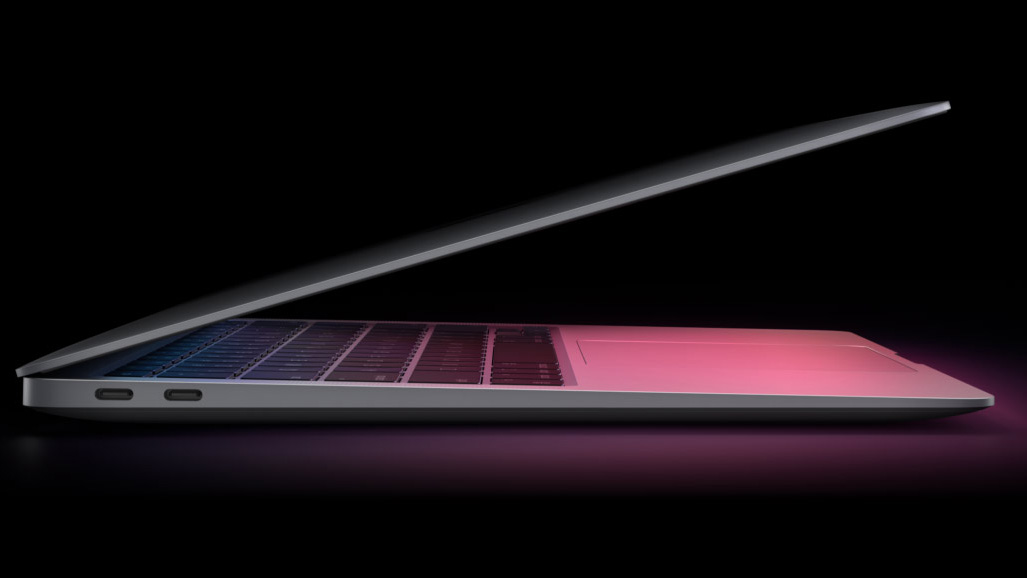Apple has finally ditched Intel for its own CPU in new MacBook Air
Apple claims the M1 is "the world's fastest CPU core when it comes to low‑power silicon."

It hasn't been a banner year for Intel. AMD stole the performance crown and owns more of the CPU market than it has in years, beating Intel with powerful multicore processors. Now after many years of building the fastest mobile chip around for the iPhone, Apple has debuted its first CPU for Macs, ditching Intel entirely in its new MacBook Air. In Apple talk: "This isn't an upgrade. It's a breakthrough."
Apple dropped a lot of cherry-picked comparisons to show that the new M1 processor offers "up to 3.5x faster CPU performance" than the last MacBook Air's Intel i7, or "3x CPU performance per watt" prior to previous MacBook Pros. The fine print on that first claim is that it's referring to transcoding a video in Apple's own Final Cut Pro software, using its own ProRes video format.
Another claim, that it "matches peak PC performance using 25 percent of the power," came from a vague test "made against latest‑generation high‑performance notebooks commercially available." It'll take real testing to see how Apple's M1 chip compares to Intel and AMD's processors in today's Windows laptops, but I don't think Apple is really trying to compete with the best gaming laptops for power. In fact, in its new MacBook Pros and Mac Minis, there are still Intel CPU options available at the high-end, signaling that the M1 isn't a match for the likes of a full-power i7 (yet). What it's really boasting about here is efficiency.
The 8-core M1 processor is built on 5nm and brings mobile-caliber power efficiency to Apple's laptops. Apple claims the new MacBook Air can get 18 hours of battery life—6 hours more than the previous model. It claims the MacBook Pro is even better at 20 hours. And there are other perks of the M1; these new Macs can now run iOS apps natively, and the same image processing Apple uses for mobile can be applied to the webcam here, too.
This is obviously a big transition point for Apple, so it's hard to know what app support will look like in its OS a few years from now. Last year, its OS update threatened years of 32-bit games with extinction. Apple hasn't entirely abandoned Intel CPUs on the x86 architecture just yet, but it's clearly moving in that direction. In another year or two, the M1's successors may be powerful enough to run even a high-end MacBook Pro.
Even if you aren't interested in Apple's hardware—the Mac is still not exactly a thriving gaming platform—it's truly an exciting year for CPU development. Apple is pushing the ARM architecture out of mobile and into computers, while AMD is making its own huge gains in laptop graphics power. Meanwhile, Nvidia is buying ARM, the company behind the architecture design used in all our mobile devices. How will that affect the future of Nvidia's hardware, or the entire computing industry? We have no idea, but it sure seems like competition is only going to grow more fierce.
Today, though, the MacBook Air may well be the best bang for your buck of any product Apple offers. The new version, which weighs 2.8 pounds, starts at $999. It's out November 17th.
Keep up to date with the most important stories and the best deals, as picked by the PC Gamer team.

Wes has been covering games and hardware for more than 10 years, first at tech sites like The Wirecutter and Tested before joining the PC Gamer team in 2014. Wes plays a little bit of everything, but he'll always jump at the chance to cover emulation and Japanese games.
When he's not obsessively optimizing and re-optimizing a tangle of conveyor belts in Satisfactory (it's really becoming a problem), he's probably playing a 20-year-old Final Fantasy or some opaque ASCII roguelike. With a focus on writing and editing features, he seeks out personal stories and in-depth histories from the corners of PC gaming and its niche communities. 50% pizza by volume (deep dish, to be specific).


